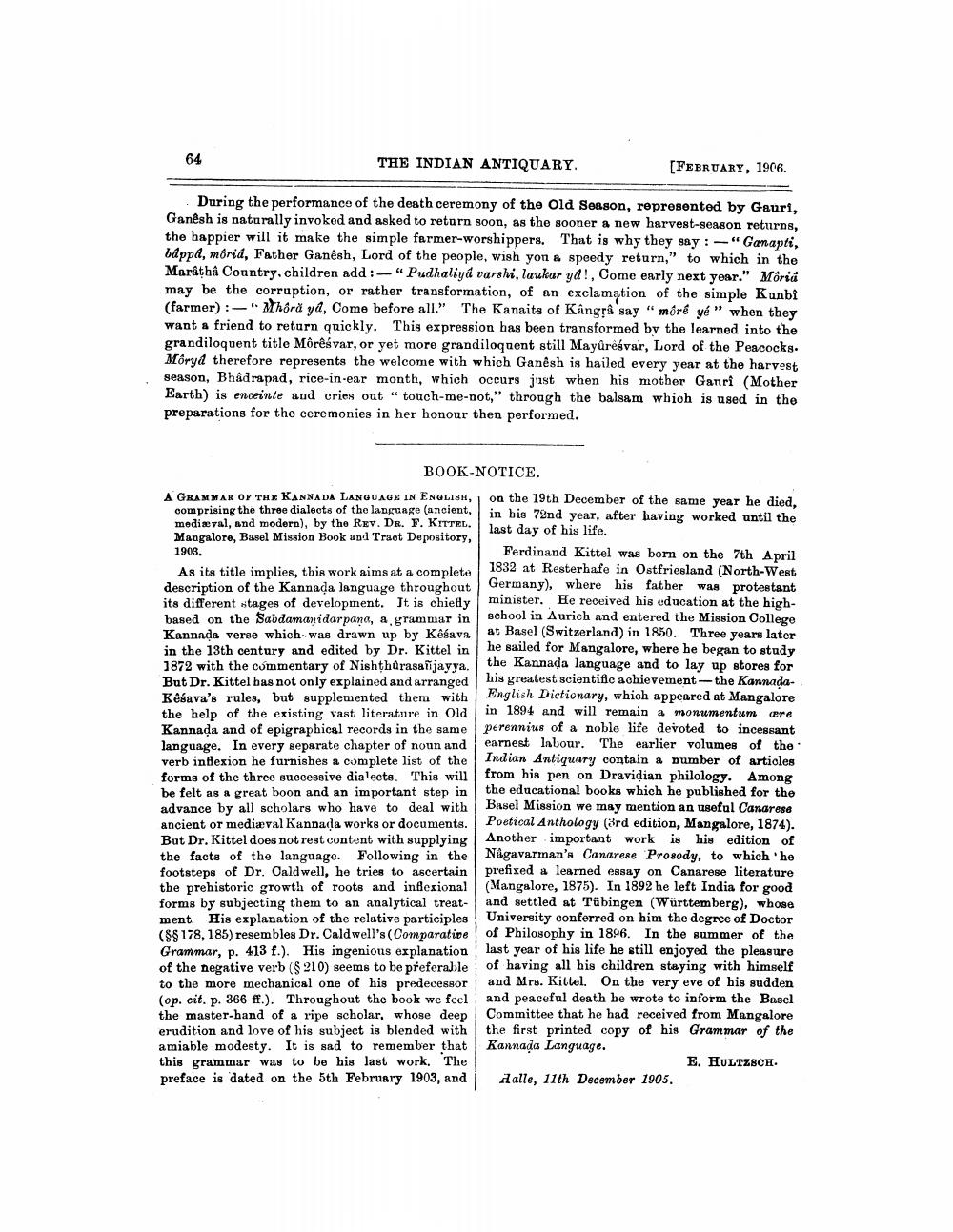________________
THE INDIAN ANTIQUARY.
[FEBRUARY, 1906.
During the performance of the death ceremony of the Old Season, represented by Gauri, Ganesh is naturally invoked and asked to return soon, as the sooner a new harvest-season returns, the happier will it make the simple farmer-worshippers. That is why they say: "Ganapti, bappa, môriá, Father Ganêsh, Lord of the people, wish yon a speedy return," to which in the Maratha Country, children add:"Pudhaliya varshi, laukar ya!, Come early next year." Môriá may be the corruption, or rather transformation, of an exclamation of the simple Kunbi (farmer): Mhóra yd, Come before all." The Kanaits of Kângrâ say "môré yé" when they want a friend to return quickly. This expression has been transformed by the learned into the grandiloquent title Môrêśvar, or yet more grandiloquent still Mayûrêśvar, Lord of the Peacocks. Môryd therefore represents the welcome with which Ganêsh is hailed every year at the harvest season, Bhadrapad, rice-in-ear month, which occurs just when his mother Ganri (Mother Earth) is enceinte and cries out "touch-me-not," through the balsam which is used in the preparations for the ceremonies in her honour then performed.
64
BOOK-NOTICE.
A GRAMMAR OF THE KANNADA LANGUAGE IN ENGLISH, comprising the three dialects of the language (ancient, medieval, and modern), by the REV. DR. F. KITTEL. Mangalore, Basel Mission Book and Tract Depository, 1903.
on the 19th December of the same year he died, in bis 72nd year, after having worked until the last day of his life.
Ferdinand Kittel was born on the 7th April 1832 at Resterhafe in Ostfriesland (North-West Germany), where his father was protestant minister. He received his education at the highschool in Aurich and entered the Mission College at Basel (Switzerland) in 1850. Three years later he sailed for Mangalore, where he began to study the Kannada language and to lay up stores for his greatest scientific achievement-the KannadaEnglish Dictionary, which appeared at Mangalore in 1894 and will remain a monumentum ære perennius of a noble life devoted to incessant earnest labour. The earlier volumes of the Indian Antiquary contain a number of articles from his pen on Dravidian philology. Among the educational books which he published for the Basel Mission we may mention an useful Canarese Poetical Anthology (3rd edition, Mangalore, 1874). Another important work is his edition of Nagavarman's Canarese Prosody, to which 'he prefixed a learned essay on Canarese literature (Mangalore, 1875). In 1892 he left India for good and settled at Tübingen (Württemberg), whose University conferred on him the degree of Doctor of Philosophy in 1896. In the summer of the last year of his life he still enjoyed the pleasure of having all his children staying with himself and Mrs. Kittel. On the very eve of his sudden and peaceful death he wrote to inform the Basel Committee that he had received from Mangalore the first printed copy of his Grammar of the Kannada Language.
As its title implies, this work aims at a complete description of the Kannada language throughout its different stages of development. It is chiefly based on the Sabdamanidarpana, a, grammar in Kannada verse which was drawn up by Kêśava in the 13th century and edited by Dr. Kittel in 1872 with the commentary of Nishthurasanjayya. But Dr. Kittel has not only explained and arranged Kesava's rules, but supplemented them with the help of the existing vast literature in Old Kannada and of epigraphical records in the same language. In every separate chapter of noun and verb inflexion he furnishes a complete list of the forms of the three successive dialects. This will be felt as a great boon and an important step in advance by all scholars who have to deal with ancient or mediaval Kannada works or documents. But Dr. Kittel does not rest content with supplying the facts of the language. Following in the footsteps of Dr. Caldwell, he tries to ascertain the prehistoric growth of roots and inflexional forms by subjecting them to an analytical treatment. His explanation of the relative participles (§§ 178,185) resembles Dr. Caldwell's (Comparative Grammar, p. 413 f.). His ingenious explanation of the negative verb (§ 210) seems to be preferable to the more mechanical one of his predecessor (op. cit. p. 366 ff.). Throughout the book we feel the master-hand of a ripe scholar, whose deep erudition and love of his subject is blended with amiable modesty. It is sad to remember that this grammar was to be his last work. The preface is dated on the 5th February 1903, and Halle, 11th December 1905.
E. HULTZSCH.




